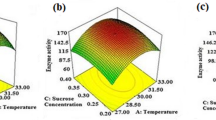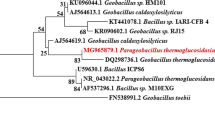Abstract
Background
The current study demonstrated the possibility of statistical design tools combination with computational tools for optimization of fermentation conditions for enhanced fibrinolytic protease production.
Methods
The effects of using different carbon and nitrogen sources for protease production by Streptomyces radiopugnans_VITSD8 were examined by a full factorial design method. The incubation time, temperature, pH of the medium, and RPM were assessed by the predictable one factor at a time (OFAT) method. Optimization was carried out using starch and oat meal as carbon source, nitrogen source as peptic and malt extract using Fractional Factorial Design (FFD). The analysis was further continued for medium volume, temperature, initial medium pH, inoculum concentration, high determination co-efficient as (R’-0.965), and lower determination co-efficient of variation (CV-8.19%), which defines a reliable and accurate experimental value.
Results
Analysis of variance by the fixed slope effect by temperature and starch; temperature and L-aspargine, temperature and oat meal, temperature and peptic extracts, temperature and pH, temperature and duration of incubation were more vital for protease production at an interactive level. Response surface plots revealed that temperature, starch, and peptic extracts affix critical concerning in temperature. Programming estimated a 28% increase in protease production. Incubation temperature and medium volume portrayed extreme impact among all factor. Starch, peptic and temperature play an important regulatory role in protease production. Optimium temperature for protease production was 33°C. The ratio of carbon and nitrogen sources and pH were the major regulatory factors in protease production by Streptomyces radiopugnans_VITSD8. It demonstrated a 4% noteworthy change in condition.
Conclusion
Among all the selected parameters, temperature was the most intuitive factor, demonstrating a notable connection with the type of media and pH, while inoculum fixation had a direct impact on protein production.
Similar content being viewed by others
References
Abdeltif A (2000). Effect of inorganic phosphate on lactate production by Lactobacillus helviticus grown on supplemented whey permeate. J Chem Technol Biotechnol, 75(3): 223–238
Adinarayana K, Ellaiah P (2002). Response surface optimization of the critical medium components for the production of alkaline protease by a newly isolated Bacillus sp. J Pharm Pharm Sci, 5(3): 272–278
Chen X C, Bai J X, Cao JM, Li Z J, Xiong J, Zhang L, Hong Y, Ying H J (2009). Medium optimization for the production of cyclic adenosine 3',5'-monophosphate by Microbacterium sp. no. 205 using response surface methodology. Bioresour Technol, 100(2): 919–924
Conto S R, Isabel R, Sanroman A (2001). Design of different bioreactor configurations: application to ligninolytic enzyme production in semi-solid state cultivation. J Chem Technol Biotechnol, 76: 78–82
Curdová E, Jechová V, Zima J, Vanek Z (1989). The effect of inorganic phosphate on the production of avermectin in Streptomyces avermitilis. J Basic Microbiol, 29(6): 341–346
Deepak V, Kalishwaralal K, Ramkumarpandian S, Babu S V, Senthilkumar S R, Sangiliyandi G (2008). Optimization of media composition for Nattokinase production by Bacillus subtilis using response surface methodology. Bioresour Technol, 99(17): 8170–8174
Dworkin M, Falkow S, Rosenberg E, Schleifer K H, Stackebrandt E (2006). The Prokaryotes. In: Ecophysiology and Biochemistry, vol 2. Springer, New York, pp. 124
Gao H, Liu M, Liu J, Dai H, Zhou X Liu X, Zhuo Y, Zhang W, Zhang L (2009). Medium optimization for the production of avermectin B1a by Streptomyces avermitilis 14-12A using response surface methodology. Bioresour Technol, 100(17): 4012–4016
Garde A, Jonsson G, Schmidt A S, Ahring B K (2002). Lactic acid production from wheat straw hemicellulose hydrolysate by Lactobacillus pentosus and Lactobacillus brevis. Bioresour Technol, 81(3): 217–223
Gheshlaghi R, Scharer J M, Moo-Young M, Douglas P L (2005). Medium optimization for hen egg white lysozyme production by recombinant Aspergillus niger using statistical methods. Biotechnol Bioeng, 90(6): 754–760
Gill P K, Sharma A D, Harchand R K, Singh P (2003). Effect of media supplements and culture conditions on inulinase production by an actinomycete strain. Bioresour Technol, 87(3): 359–362
Guo W Q, Ren N Q, Wang X J, Xiang W S, Ding J, You Y, Liu B F (2009). Optimization of culture conditions for hydrogen production by Ethanoligenens harbinense B49 using response surface methodology. Bioresour Technol, 100(3): 1192–1196
Gupte T E, Naik S R (1998). Optimisation of nutritional requirements and process control parameters for the production of HA-2–91, a new tetraene polyene antibiotic. Hindustan Antibiot Bull, 40: 5–13
Ikeda H, Omura S (1995). Control of avermectin biosynthesis in Streptomyces avermitilis for the selective production of a useful component. J Antibiot (Tokyo), 48(7): 549–562
Ikeda H, Omura S (1997). Avermectin Biosynthesis. Chem Rev, 97(7): 2591–2610
Jia B, Jin Z H, Mei L H (2008). Medium optimization based on statistical methodologies for pristinamycins production by Streptomyces pristinaespiralis. Appl Biochem Biotechnol, 144(2): 133–143
Jonsbu E, McIntyre M, Nielsen J (2002). The influence of carbon sources and morphology on nystatin production by Streptomyces noursei. J Biotechnol, 95(2): 133–144
Kar S, Ray R C (2008). Statistical optimization of alpha-amylase production by Streptomyces erumpens MTCC 7317 cells in calcium alginate beads using response surface methodology. Pol J Microbiol, 57(1): 49–57
Knight V, Sanglier J J, DiTullio D, Braccili S, Bonner P, Waters J, Hughes D, Zhang L (2003). Diversifying microbial natural products for drug discovery. Appl Microbiol Biotechnol, 62(5–6): 446–458
Krishnan S, Bhattacharya S, Karanth N G (1998). Media optimization for production of lactic acid by Lactobacillus plantarum NCIM 2084 using response surface methodology. Food Biotechnol, 12(1/2): 105–121
Li W, Rasmussen H T (2003). Strategy for developing and optimizing liquid chromatography methods in pharmaceutical development using computer-assisted screening and Plackett-Burman experimental design. J Chromatogr A, 1016(2): 165–180
Li Y, Jiang H, Xu Y, Zhang X (2008). Optimization of nutrient components for enhanced phenazine-1-carboxylic acid production by gacA-inactivated Pseudomonas sp. M18G using response surface method. Appl Microbiol Biotechnol, 77(6): 1207–1217
Liu G Q,Wang X L (2007). Optimization of critical medium components using response surface methodology for biomass and extracellular polysaccharide production by Agaricus blazei. Appl Microbiol Biotechnol, 74(1): 78–83
Liu S, Fang Y, Lv M, Wang S, Chen L (2010). Optimization of the production of organic solvent-stable protease by Bacillus sphaericus DS11 with response surface methodology. Bioresour Technol, 101 (20): 7924–7929
Lotfy W A (2007). The utilization of beet molasses as a novel carbon source for cephalosporin C production by Acremonium chrysogenum: Optimization of process parameters through statistical experimental designs. Bioresour Technol, 98(18): 3491–3498
Mu W, Chen C, Li X, Zhang T, Jiang B (2009). Optimization of culture medium for the production of phenyllactic acid by Lactobacillus sp. SK007. Bioresour Technol, 100(3): 1366–1370
Naveena B J, Altaf M, Bhadrayya K, Madhavendra S S, Reddy G (2005). Direct fermentation of starch to l(+) lactic acid in SSF by Lactobacillus amylophilus GV6 using wheat bran as support and substrate: medium optimization using RSM. Bioprocess Biochemistry, 40(2): 681–690
Pillai P, Mandge S, Archana G (2011). Statistical optimization of production and tannery applications of a keratinolytic serine protease from Bacillus subtilis P13. Process Biochem, 46(5): 1110–1117
Shabbiri K, Adnan A, Jamil S, Ahmad W, Noor B, Rafique H M (2012). Medium optimization of protease production by Brevibacterium linens DSM 20158, using statistical approach. Braz J Microbiol, 43 (3): 1051–1061
Xavier S, Lonsane B K (1994). Sugarcane press mud as a novel and inexpensive substrate for production of lactic acid in a solid state fermentation system. Appl Microbiol Biotechnol, 41(3): 291–295
Acknowledgments
The authors thank VIT University for providing the ‘VIT SEED GRANT’ for carrying out this research work.
Author information
Authors and Affiliations
Corresponding author
Rights and permissions
About this article
Cite this article
Duraikannu, D., Chandrasekaran, S.D. Optimization and modeling studies on the production of a new fibrinolytic protease using Streptomyces radiopugnans_VITSD8. Front. Biol. 13, 70–77 (2018). https://doi.org/10.1007/s11515-017-1476-9
Received:
Accepted:
Published:
Issue Date:
DOI: https://doi.org/10.1007/s11515-017-1476-9




